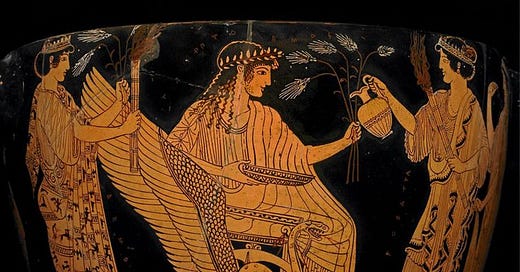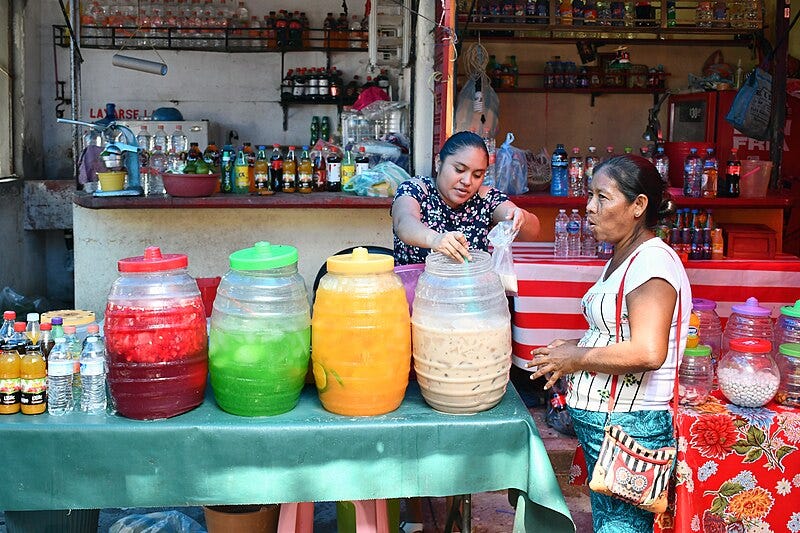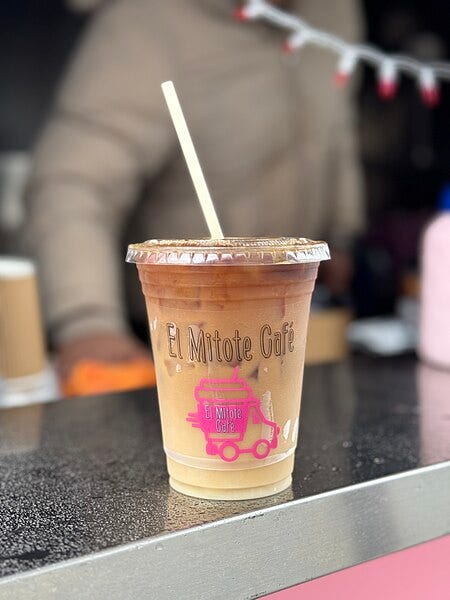For a Glass of Horchata
How an ancient secret religion, the expansion of the Roman Empire, Spanish Conquistadors, and taco shops led to the latest coffee shop craze.
In Greece, a few kilometers northeast of Athens, lies the city of Eleusis (now called Elefsina). In ancient Eleusis, on a hill overlooking the Mediterranean, was built the Telesterion, a ritual temple dedicated to the worship of Demeter, goddess of agriculture. Beginning in about 600 BC, Demeter’s cult observed an annual tradition: each year, initiates from all over ancient Greece would make a pilgrimage to Eleusis to participate in the legendary Eleusinian mysteries, a week-long series of secret purification rituals, sacrifices, and ceremonies. Very little is known about these rituals- the initiates were sworn to extreme secrecy- but we know that at least one ceremony featured the drinking of kykeon.
Kykeon was a beverage made of water and boiled barley. It was a common drink among the ancient Greeks, who also called it ptisane; the boiled barley brought sweetness to the water, along with a characteristic cloudy white hue. The drinking of barley-water made sense in the context of Demeter-worship - she was the goddess who gave us the grain, after all. And barley was especially important in ancient times as the basic grain: agriculture was barley and barley was agriculture. The Telesterion was decorated with carvings of barley sheaves, and the rituals were said to include the silent contemplation of a single ear of barley. Herbs were added to flavor the drink, but many historians think there was an extra ingredient in ceremonial kykeon: ergot, a fungus that can infect barley seeds. Ergot contains a number of toxic and psychoactive alkaloids, including lysergic acid, the chemical which forms the building blocks of LSD. Consuming ergot can produce convulsions and hallucinations, and it’s speculated that the Eleusinian kykeon might have been especially formulated with ergot to produce otherworldly, psychedelic experiences for the initiates.
Demeter and her daughter Persephone give the gift of barley to the world, a central theme of the Eleusinian mysteries. Is that kykeon in the jar?
The Eleusinian mysteries were observed for hundreds of years, and during the Roman period the rituals became popular among Roman elites. And the consumption of (non-psychedelic) kykeon became popular among the Romans too. As the drink’s popularity grew, the Romans gave it a new name, after their word for barley, hordeum. They called barley-water hordeata.
Just as in Greece, Roman hordeata was extremely common among all classes. Barley-water is economical as well as refreshing; you can boil the barley, using the boiled grains to eat and the barley water to drink. In addition to flavoring hordeata with herbs, Romans began adding spices and almonds to the brew. Almonds contribute milkiness, sweetness and flavor to hordeata, in addition to being a good source of creamy fat.
Hordeata spread wherever the Romans went, from Roman Britain to France and Spain. And in all of these places, it changed names and recipes. In Britain, the almonds never caught on, but the drinking of barley-water did: it is a beloved summertime tradition, and the Robinsons brand makes a popular bottled version. In Italy, almonds ended up dominating the flavor profile of hordeata, and the drink became called orzata in modern Italian. Today, though Italian orzata can be made with barley, it’s more often made from a syrup of almonds and sugar, sometimes flavored with lemon. This is the drink that became popular in France, where it is called orgeat, and often contains a dash of orange blossom. In Spain, hordeata became horchata, and encountered a new ingredient: a nutlike tuber called chufa, imported from Africa. Chufas make delicious horchata, and the Spanish substituted them for almonds and barley, adding a bit of cinnamon to the refreshing, creamy drink, called horchata de chufa.
The spread of barley-water from Greece to Europe and beyond
The desire for horchata de chufa accompanied the Spanish colonists to the new world, but chufas never quite caught on in the colonies. However, a new basic grain did: the Asian staple, rice. Rice was imported by the Spanish conquistadors in the 16th century from both Europe and the Philippines, and at some point Mexican cooks realized that rice makes a delicious version of Spanish horchata. The cinnamon flavor stuck, and Mexican rice-based horchata became included in the pantheon of aguas frescas, the delicious, flavored waters of Mexican cuisine.
Aguas frescas in Juchitán de Zaragoza, with horchata on the right. photo Gzzzz, creative commons
Since the 1960s, Mexican food has enjoyed growing popularity in the US and abroad. Tacos, taquerias and taco trucks are universally beloved, and regional specialties like birria have become on-trend dishes among foodies and the general public alike. Horchata has ridden this wave of Mexican-food popularity, and over the past several years the beverage has broken out of the taco shop and into the American mainstream. One can get Mexican-style horchata at convenience stores and upscale restaurants; stores offer horchata-flavored ice cream, donuts, and cocktails. Horchata’s creamy sweetness makes it an ideal complement for coffee; nobody knows who first had the idea to combine the two. However, when LA’s Tierra Mia coffee opened their first shop in 2008, the Horchata Latte- a mixture of espresso and steamed horchata- was on the menu. Since then, horchata-based coffee beverages have been proliferating throughout the west coast- from Contra Coffee’s “Dirty Horchata” to the Black Rice Horchata Latte of Santa Ana’s Café Cultura.
Horchata latte at El Mitote Cafe, Ukiah, California by Sarah Stierch (CC BY 4.0)
And we owe these coffeeshop specialties to ancient Greek goddess worship, the expansion of the Roman empire, the Spanish conquest of Mexico, and the delicious greatness of the taco shop.








An interesting variety of horchata is the use of light roasted barley powder mixed with sugar and cinnamon. You can find it at every seafood place in Mazatlán (Sinaloa) and the surrounding towns on the way to the north and to the east roads towards Durango. There are even versions as ice cream and posicle.
Cyperus esculentus also known as chufa or horchata is a very invasive plant. It is considered as problematic in Europe and even blacklisted in some coubtries like Switzerland.
So, taste and flavour are nice, but it could be an ecological problem.